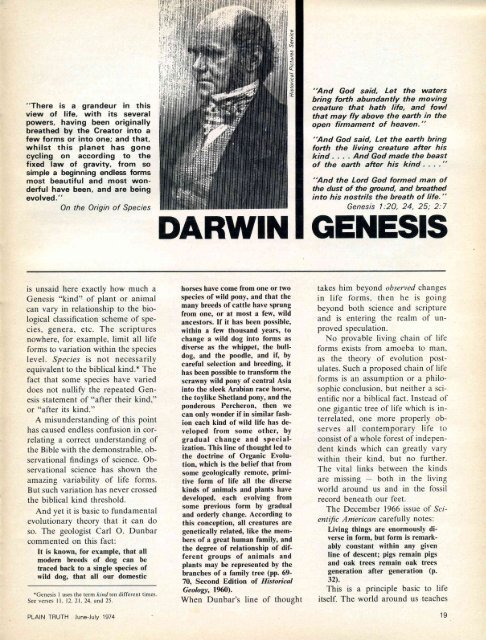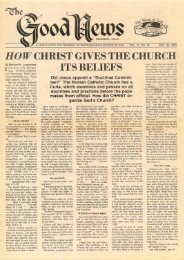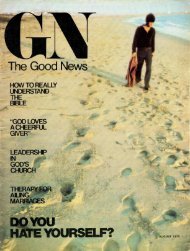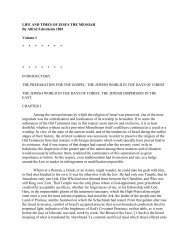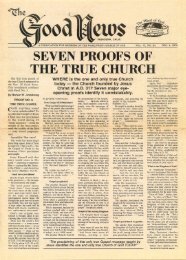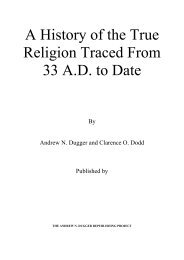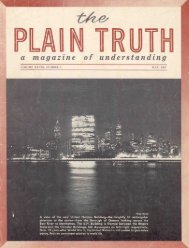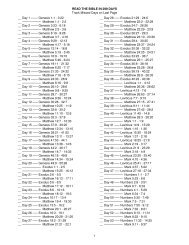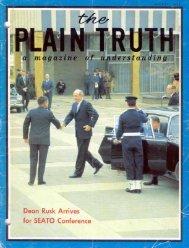You also want an ePaper? Increase the reach of your titles
YUMPU automatically turns print PDFs into web optimized ePapers that Google loves.
"There is a grandeur in this<br />
view of life. with its several<br />
powers. having been originally<br />
breathed by the Creator into a<br />
few forms or into one; and that.<br />
whilst this planet has gone<br />
cycling on according to the<br />
fixed law of gravity. from so<br />
simple a beginning endless forms<br />
most beautiful and most wonderful<br />
have been. and are being<br />
evolved."<br />
On the Origin of Species<br />
DARWIN<br />
"And God said, Let the waters<br />
bring forth abundantly the moving<br />
creature that hath life, and fowl<br />
that may fly above the earth in the<br />
open firmament of heaven. "<br />
"And God said, Let the earth bring<br />
forth the living creature after his<br />
kind . ... And God made the beast<br />
of the earth after his kind . ... "<br />
"And the Lord God formed man of<br />
the dust of the ground, and breathed<br />
into his nostrils the breath of life. "<br />
Genesis 1 :20, 24, 25; 2: 7<br />
GENESIS<br />
is unsaid here exactly how much a<br />
Genesis "kind'! of plant or animal<br />
can vary in relationship to the biological<br />
classification scheme of species,<br />
genera, etc. The scriptures<br />
nowhere, for example, limit all life<br />
forms to variation within the species<br />
level. Species is not necessarily<br />
equivalent to the biblical kind. * The<br />
fact that some species have varied<br />
does not nullify the repeated Genesis<br />
statement of "after their kind,"<br />
or "after its kind."<br />
A misunderstanding of this point<br />
has caused endless confusion in correlating<br />
a correct understanding of<br />
the Bible with the demonstrable, observational<br />
findings of science. Observational<br />
science has shown the<br />
amazing variability of life forms.<br />
But such variation has never crossed<br />
the biblical kind threshold.<br />
And yet it is basic to fundamental<br />
evolutionary theory that it can do<br />
so. The geologist Carl O. Dunbar<br />
<strong>com</strong>mented on this fact:<br />
It is known, for example, that all<br />
modem breeds of dog can be<br />
traced back to a single species of<br />
wild dog, that all our domestic<br />
'Genesis I uses the term kind ten different times.<br />
See verses II. 12.21. 24. and 25.<br />
PLAIN TRUTH June-July 1974<br />
horses have <strong>com</strong>e from one or two<br />
species of wild pony, and that the<br />
many breeds of cattle have sprung<br />
from one, or at most a few, wild<br />
ancestors. If it has been possible,<br />
within a few thousand years, to<br />
change a wild dog into forms as<br />
diverse as the whippet, the bulldog,<br />
and the poodle, and if, by<br />
careful selection and breeding, it<br />
has been possible to transform the<br />
scrawny wild pony of central Asia<br />
into the sleek Arabian race horse,<br />
the toy like Shetland pony, and the<br />
ponderous Percheron, then we<br />
can only wonder if in similar fashion<br />
each kind of wild life has developed<br />
from some other, by<br />
gradual change and specialization.<br />
This line of thought led to<br />
the doctrine of Organic Evolution,<br />
which is the belief that from<br />
some geologically remote, primitive<br />
form of life all the diverse<br />
kinds of animals and plants have<br />
developed, each evolving from<br />
some previous form by gradual<br />
and orderly change. According to<br />
this conception, all creatures are<br />
genetically related, like the members<br />
of a great human family, and<br />
the degree of relationship of different<br />
groups of animals and<br />
plants may be represented by the<br />
branches of a family tree (pp. 69-<br />
70, Second Edition of Historical<br />
Geology, 1960).<br />
When Dunbar's line of thought<br />
takes him beyond observed changes<br />
in life forms, then he is going<br />
beyond both science and scripture<br />
and is entering the realm of unproved<br />
speculation.<br />
No provable living chain of life<br />
forms exists from amoeba to man,<br />
as the theory of evolution postulates.<br />
Such a proposed chain of life<br />
forms is an assumption or a philosophic<br />
conclusion, but neither a scientific<br />
nor a biblical fact. Instead of<br />
one gigantic tree of life which is interrelated,<br />
one more properly ob-<br />
. serves all contemporary life to<br />
consist of a whole forest of independent<br />
kinds which can greatly vary<br />
within their kind, but no further.<br />
The vital links between the kinds<br />
are missing - both in the living<br />
world around us and in the fossil<br />
record beneath our feet.<br />
The December 1966 issue of Scientific<br />
American carefully notes:<br />
Living things are enormously diverse<br />
in form, but form is remarkably<br />
constant within any given<br />
line of descent; pigs remain pigs<br />
and oak trees remain oak trees<br />
generation after generation (p.<br />
32).<br />
This is a principle basic to life<br />
itself. The world around us teaches<br />
19


